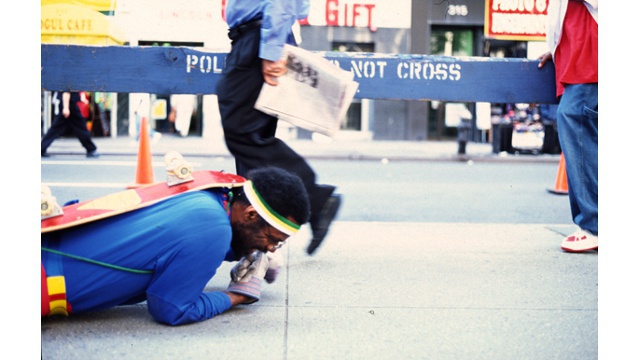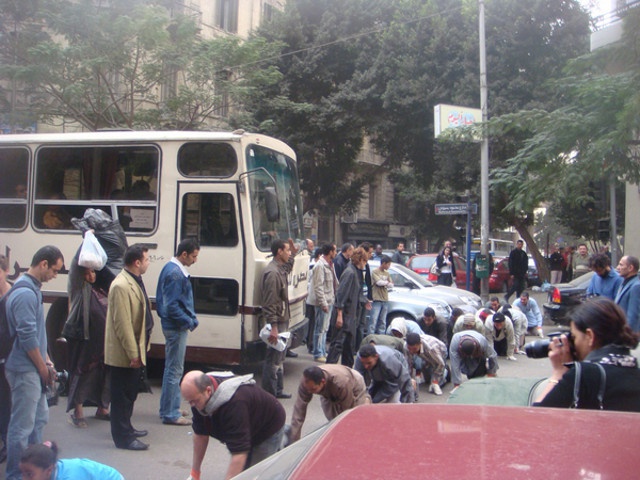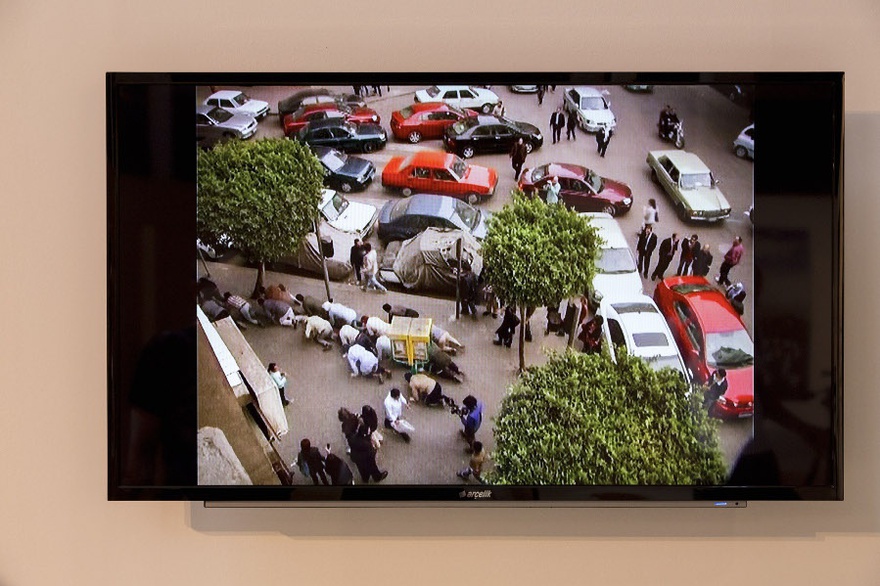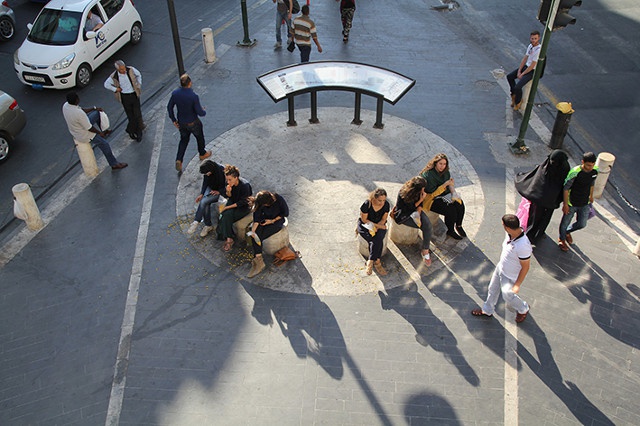It's December 2009. I arrive in Cairo for the first time only a few weeks after Amal Kenawy's controversial street performance Silence of the Sheep was staged. In a nutshell, Kenawy dressed in overalls and big sunglasses, led a group of 15 people – mostly male labourers – crawling on their hands and knees across Champollion Street a busy area in downtown Cairo. As I make my way around the city, visiting artist studios, I hear chatter surrounding the event: people were angry, there was hostility. The artist, performers, and some members of the public were arrested and released 24 hours later.
As it was performed, the contracted male participants outnumbered the women. In an effort to balance these gender dynamics, Rifky and two other children volunteered to participate. They were all dressed in neutrally-coloured pyjamas, a choice that could not fully conceal the markers of class and gender, nor gloss over their radically different incentives for participating in the work.
Amal Kenawy, Silence of the Lambs/Sheep, 2009. Installation view at the 13th Istanbul Biennial, 2013. Performance and video transferred to DVD, PAL, 4:3, 8:51 min. Courtesy The Amal Kenawy Estate and Istanbul Foundation for Culture and Arts.
Photo: Servet Dilber.
Initially, Kenawy wanted her art students to perform the work, so as to refer to the culture of hierarchies perpetuated within the Egyptian educational system. However, at the last minute, these students withdrew their participation prompting the artist to hire 'workers' to perform as actors. For her, this change in the kind of participants - the reasons behind their involvement and how they were asked to perform - did not change the meaning of the work. But before elaborating on the implications of employing workers - day labourers, essentially - to crawl on the street as part of an art performance, I would pause to reflect on why a group of middle class art students decided to silently withdraw their participation. Did they fear the humiliation that they might encounter on the street? Was this last minute silent withdrawal a resistance to the dominant 'sheep mentality' that Kenawy was criticising? Or were they simply not convinced of the gesture?
In reality, Silence of the Sheep was met with resistance even before it was performed on the street. One has to wonder why no discussion with the concerned art students took place, nor was their departure documented to feed into the work as was the case with the documented fights that later broke out.
Amal Kenawy, Silence of the Lambs/Sheep, 2009. Installation view at the 13th Istanbul Biennial, 2013. Performance and video transferred to DVD, PAL, 4:3, 8:51 min. Courtesy The Amal Kenawy Estate and Istanbul Foundation for Culture and Arts.
Photo: Servet Dilber.
III.
Anticipating that the performance would provoke reactions, Kenawy's key rule was simple: do not verbally engage with the public. However, once they hit the first café, Kenawy broke her own rule.
FIGHT # 1 – Transcribed from Kenawy's video
Amal Kenawy: This is performance art. It's an artwork…
Member of the Public: And who are you again?
AK: We are moving the artwork into the street!!
MP: And who are you again?
Who are you!!!
You are humiliating them on the floor.
You call this art?
AK: I believe that!
MP: They told you that making people walk like animals is art?!!!
AK: Like something called Aragoz.
Aragoz art is all about interaction with people walking in the street out of the traditional indoor art forms like cinema and gallery space.
MP: You mean pantomime?
AK: Kind of … So we are trying to connect our point of view to our community.
MP: But, not in that way.
You are making some poor workers performing like animals!
MP: Not intellectual or decent
AK: It's an open call why don't you come and participate!
MP: And why should I?!!
What is the cause?[6]
'Had we continued', Rifky remarked, 'I think it would have been fine, but instead the work turned into a discussion around Amal… I was not afraid, but I was disappointed that she went off-script. The street fight became the "object" which was a clear departure from the subtle silent performance we were invited to be part of.'[7]
What Rifky described is embodied in the 10-minute video documentation that Kenawy released a year later. Labelled in segments as 'Fight #1' and 'Fight #2', the video opens with the following line on a black screen: 'I noticed that all the milestones of my life are near Christmas time!' It ends with a black screen titled 'Fight # 3', followed by the sentence: 'continued till early morning, no more documentations were collected.' The opening line situates the public performance and the public outcry within Kenawy's personal story as the sole narrative.
This edited footage first surfaced on December 2010 within Kenawy's elaborate multi-media installation at the Palace of the Arts as part of the 12th International Cairo Biennale. Installed within a room adorned by Christmas lights and graffiti drawings by Kenway's then ten year-old son, Yassin, the documentation footage was situated within two other video projections by the artist; one of a young man unsuccessfully trying to escape from a wheelchair, and the other a video of Kenawy's son Yassin playing the piano on his birthday. Within this context, Silence of the Sheep was further anchored in Kenawy's personal narrative and domestic space. To highlight the irony of it all, the installation merited Kenawy the 12th International Cairo Biennale's Grand Prize, prompting art critic Kaelen Wilson-Goldie to wonder if the public message was that 'on the streets the performance was a problem', but as a moving image, as a personal anecdote within a museum space, it was fine.[8]
Since then, Silence of the Sheep has been exhibited as a single channel video installation in many international biennial exhibitions and museum shows. Now baring aesthetic resemblance to the iconic images and sounds of resistance that emerged out of the 25 January Egyptian Uprisings in 2011, the work was quickly embraced and celebrated within a renewed interest in 'protest art'. Yet, while the personal contextualization of Silence of the Sheep allowed for the work to resurface in some form in Cairo, it also managed to escape some of the critical questions that emerged from the artistic conception and execution of the work: the aloofness to nuances of class and gender which was later misbranded within the art world as forms of feminism and activism. In other words, what was lost was a discussion surrounding the discrepancies between 'bringing art to the street' instead of art being part of the street.
Amal Kenawy, Silence of the Lambs/Sheep, 2009. Installation view at the 13th Istanbul Biennial, 2013. Performance and video transferred to DVD, PAL, 4:3, 8:51 min. Courtesy The Amal Kenawy Estate and Istanbul Foundation for Culture and Arts.
Photo: Servet Dilber.
In the 10-minute video the presents the performance as an edited document, Kenawy becomes a symbol that implicates the complex relationship between contemporary art and the public sphere.Reviewing the transcripts of the fight only further illustrates this point. While the men, obviously angry, are questioning the integrity and value of Kenawy's gesture, she is trying to explain to them that what they see is performance art. As a form of contemporary art that is usually seen within the confines of the gallery space, she assumes that they might not understand it, so she tries to break it down for them in analogies they might understand: 'It is like Aragoz', she says, referring to a tradition of street puppetry in Egypt that encourages audience engagement. But unlike Aragoz, these actors are not 'puppets' appearing on a clearly marked stage. Kenawy then asks, and never receives a response: 'what if this was a film, would you have objected?'
There is a strong chance no one would have objected if the performance was part of a scene for a film. This would immediately imply that it is fiction, located within other fictional scenes that would render some legitimate meaning to what the public overwhelmingly perceived as a 'humiliating act'. Yet, unlike film, a performance realised in the public realm invites reaction and engagement that can even change its course, which is exactly what happened in Silence of the Sheep.
IV.
Ironically, Silence of the Sheep insinuated an image of political apathy that was met with aggressive resistance and total moral dismay. While the work is a literal mirroring of the image of a hierarchical culture ultimately soliciting submissive attitudes in Egypt, it could neither celebrate nor accept the crowd's resistance and rejection of this very image. Those who came to Kenawy's defence, argued that the reaction to Silence of the Sheep performance would have been radically different had the leader of the pack been embodied by a male figure. This implies that the fights were primarily triggered by the presence of a public leadership figure embodied in a female body, while the moral and political objections were used as an excuse to attack and discredit that very body.
It is within these complex dynamics of art, gender and class that the confusion around Silence of the Sheep was inflamed. For if the work is deemed feminist, then by the same token we need to address the fact that this form of feminism is a by-product of a certain aloofness to gender and class, and if on the other hand it is a form of activism then its 'enlightened' (read: preachy) art tone harpers back to a colonial attitude, now possibly embodied by the Egyptian middle class.
Predominately, artistic gestures by female contemporary artists in the Arab world are entangled within these complex dichotomies. Often perceived, by the wider public, as non-populist and foreign, since they are usually part of an upper or middle class that is seen to be disconnected from the street and thus should have no right to speak on its behalf. Within 'T-Jassad'[9], a public programme on art and gender politics in public space that I co-curated with Sally Shalabi at Makan Art Space in Amman in 2015, we allocated some much needed time and space to address this issue from the perspective of leading female figures who have initiated art spaces and public engagement projects in Amman. Urban anthropologist Asseel Sawalha was commissioned to facilitate a seminar entitled 'Accidental or Intentional Gentrification?'' During our discussions, spoken-word poet Aysha El-Shamayleh questioned how her male peer performers and rappers could always speak on behalf of the underdog, the poor, and represent the voice of the people, even if they belonged to the middle and upper classes. For El-Shamayleh, her work is positioned on the outskirts or margins, and met with resistance when she attempts to bring it into a public discourse and open it up to wider conversations.
There was a unanimous sentiment shared by the participants, including Noura Khasawneh and Toleen Touq (initiators of Spring Sessions, an experiential learning program and art residency), and Lubna Juqqa, programme co-ordinator of the Balad Theater in Amman. The women expressed a feeling of alienation from the dominant populist discourse, and the very act of creating such spaces and initiatives was to challenge and insist on being part of the public conversation. As the discussion continued, it was clear that sometimes these spaces and initiatives become places of safety where we find refuge, but also sites of a continued struggle when it comes to having real and popular authenticity.[10]
On the Intersection of Fulfilment and Happiness Street, a public intervention by Noura Salem, Yvonne Buchheim, and Shuruq Harb. Performers: Melika Abdel Razzeq, Marta Bellingreri, Suzan Ibrawesh, Rola Khouri, Dima Maurice, Noura Salem. Video recording and editing: Jordan Byron. Commissioned by T-Jassad by Makan Art Space and ArtsCollaboratory. (2015)
Courtesy the artists.
This became more concrete to me when collaborating with artists Noura Salem and Yvonne Buchheim in a public performance commissioned by T-Jassad entitled On the Intersection of Fulfilment and Happiness Street, 2015. The performance was staged on an intersection in downtown Amman and instigated an act of female 'loitering' – hanging out in public without a specific useful or productive task. Six different women sat around a public roundabout with small bags of tormus, which they peeled onto the ground and ate. The piles of tormuspeels functioned as an indication of the time spent, as well as being a physical trace and remnant of the performance. To our surprise, the public reacted to the work in terms of littering rather than loitering, even though we intended to clean the space once we were done. Passers-by pointed out to their daughters how disgraceful it was that decent looking women were littering. I mention this example to emphasise that any mundane activity performed by a woman within a local public context may quickly be framed within a moral framework so as to camouflage the real issue at stake: the positioning of gender in the public realm.
I found myself thinking about this performance again when talking with a group of Amman male artists and writers who pointed out to me that they disliked it when their female peers complained and reacted to working class men littering on the street. 'Don't they understand these men don't feel that they have any stake in the public sphere?' asked one. 'All this money that is invested into making these streets, and pavements are not created for these men to enjoy. They litter because they don't perceive this space to be their own.'
If public space is not for all and if no one is trying to reclaim it, then what do we mean by public space? Is the concept simply representative of physical intersections where we quietly pass each other as we go on with our private lives? What I concluded is that public space is first and foremost engineered to keep in place social divisions, in which all the different social entities are pitted against one another, and made to feel defensive and threatened by the presence of the other, so as to say that a common public entity could only work if each lived within their designated space. Within this perspective, a conversation about littering is less about hygiene and more about class and gender behaviour in the public sphere.
V.
William Pope.L has performed more than 30 'crawl' pieces over the last three decades. The Great White Way, 22 Miles, 9 Years, 1 Street, was the first crawl.[11] It saw the artist, dressed as a cape-less Superman with a skateboard, crawled across Broadway in Manhattan. Knees and elbows to the floor, it took 6 blocks at a time, 22 miles, and 9 years to complete.
It is easy to visualize the socio-political subversion of American iconography in Pope.L's performance. The absurdity of the comic image conjures up a number of dichotomies; the disabled superhero, the strong willed man, empowerment entangled in vulnerability, resistance found in a traditional posture of submissiveness. When asked if he enjoyed crawling alone on the streets, Pope.L responded: 'No, I did not enjoy crawling…From its very earliest beginnings, the crawl project was conceived as a group performance. Unfortunately for me, at that time, I was the only volunteer.'[12] However, he acknowledged that, 'The work's initial strangeness as a solo activity made it more attractive to the art world because it took on a more object-like character, more personal and maverick.'[13] His later crawl performances would successfully involve more volunteers and ditch the superhero look. For Pope.L 'Sharing the pain, as it were, allowing the experience of public prostration in motion to be public in a larger way, across more than one body, created a stronger argument for the work as a means, not just an anomaly.[14]
Revisiting Pope.L's practice brings us back to two of the most important physical gestures in Silence of the Sheep: walking versus crawling. Kenawy's leadership in the form of 'walking' made her an anomaly within her own performance and shifted attention away from the shared physical pain of crawling together. That the artist herself was not on her hands and knees alienated her from the group that she was leading, even if they were understood to be enacting the gesture of crawling as a symbol within an image. What Pope. L's work makes clear is that it is impossible to assume the role of leadership if you don't know what it means to crawl on your hands and knees.
[1] Assume the Position (13 December 2009–17 January 2010) at the Townhouse Gallery was a group exhibition that took as a starting point the idea of loss of focus: "The offstage moment becomes central, the minor player the star, the prop the protagonist, the interior monologue the script. Attention gets shifted to the "wrong" thing, questioning what the main event actually is, and who, in fact, is the audience." It featured artists: Osama Dawod; Sanja Iveković; Cyprien Gaillard; Amal Kenawy; David Levine; Jill Magid; Enrique Metinides; Walid Raad.
[3] Special thanks to Suha Shoman and Darat Al Funun for providing access to view the videos.
[5] Sarah Rifky in conversation with the author.
[6] Video access granted by Darat Al-Funun.
[7] Sarah Rifky in conversation with the author.
[9] T-Jassad was produced by Makan Art Space and Arts Collaboratory (2014/2015)
[10] By 'authenticity', I mean that which contains a perceived impact and meaning rather than being dismissed as a hobby.











